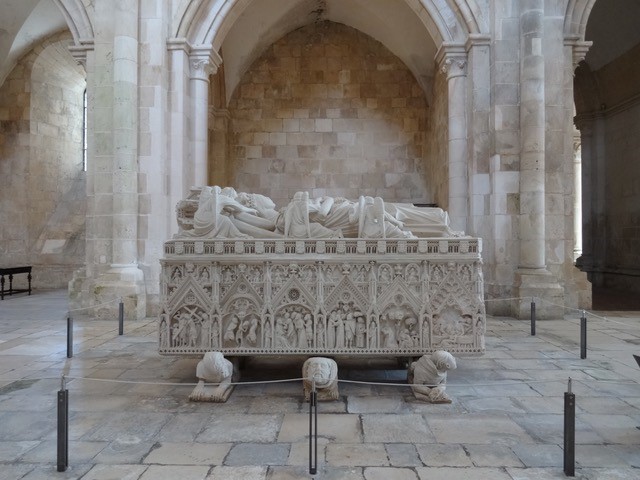PRIVACY Seminar with Professor Maria José Goulão
“The effigial tombs of Pedro I and Inês de Castro at Alcobaça (c. 1360-67): building up a narrative of female virtue, from private biography to public display.”

ABSTRACT: The tragic memory of the love of king Pedro I and Inês de Castro is forever materialized in the tombs preserved at the Cistercian abbey of Alcobaça, undoubtedly one the most outstanding works of Portuguese medieval sculpture. Due to their complexity, their astonishing plastic quality, and to the personal story behind them, the tombs have given rise to the most diverse readings, interpretations and studies. This seminar intends to place the double tombs of Pedro and Inês at the intersection of very large conceptual domains, namely ‘privacy’, ‘identity’, ‘body’ and ‘death’, as a cultural, interdisciplinary study, departing from my point of view as an art historian.
Saint Isidore of Seville’s remarks about the nature of the monumental as that which admonishes the mind was an idea intended first for the tomb. Tombs were devices that enabled visual eulogies, stressing the exemplarity of individual biography. As we know, the medieval individual was not an individuum, but a corporate entity of body and soul. At the Cistercian abbey of Alcobaça, a sober and intense way of communion with the dead was adopted. Monks were the new keepers of the memory of the deceased, anticipating eternal grace with their prayers. By their prestigious location, the aristocratic bodies of the deceased couple were both symbolically and structurally at the centre of the monastery’s religious life: being placed close to the main altar, they were the recipients of many spiritual benefits for the soul. The tombs also fixated the memory of the deceased at a site of institutional authority and continuity. This was particularly relevant due to the secrecy, illegitimacy and adulterous traits that had defined the relationship between Pedro and Inês. At the time, marriage was one of society’s core institutions, and the adulterous couple was guilty of having challenged it.
As well as claiming that a clandestine marriage, by canonical law, had taken place before Inês’s assassination at the hands of a faction opposed to Pedro’s political interests, when he was still merely the heir of the Portuguese throne, the funerary monuments commissioned after 1358 by Pedro I himself, once he became the king of Portugal, strategically aim to rehabilitate Inês’s memory and to legitimate this relationship.
We will discuss how, by means of very precise and sophisticated display strategies, these fine works of art create an official image of the couple that highlights and sacralises their union: prospectively enabling both their souls’ salvation, reinforcing Inês’s status as a queen post-mortem, and retrospectively recreating the couple’s private biography and tragedy in a very original way, asserting Inês as an exemplary figure of private and domestic feminine virtues, whose individual sufferings identify with God’s martyrdom.

Maria José Goulão is an Art Historian and an Associate Professor at the Faculty of Fine Arts, Univ. of Porto, Portugal. She holds a PhD in Art History (Univ. of Coimbra, 2005). At her Faculty, she is presently responsible for 6 courses, ranging from Medieval, Renaissance and Baroque Art, to Studies in Modern and Contemporary Art, a Seminar in Contemporary Themes of Art History and Visual Culture, and a Seminar (research tutorial) for Fine Arts PhD students.
She was responsible for full courses at the Faculty of Arts of the University of Coimbra, at the Faculty of Sciences of the University of Porto, and at Doctorate Programs, both from the Universidad Pablo de Olavide (Seville, Spain), on South American Colonial Art, and from III-UC, University of Coimbra, on Cultural Heritages of Portuguese Influence. She lectured for short periods of time at the Fine Arts Academy of Karlsruhe, at the École Supérieure d’Art d’Aix-en-Provence, at the Accademia di Belle Arti di Verona, at the Faculty of Icelandic and Comparative Cultural Studies of the University of Iceland, at the Academy of Fine Arts and Design of Ljubljana, and at the Department of Portuguese and Lusophone Studies of the University of Goa, India.
She is a researcher at GEMA (Group of Multidisciplinary Studies in Art, CEAACP), and a member of the Portuguese Association of Art Historians, of ICOMOS, and of ICOM.
Her main areas of interest are colonial art (especially in South America), artistic and cultural transfers in the South Atlantic space, circulation of images, representations of otherness, late-medieval and pre-modern funerary sculpture, and the iconography of Death and the Beyond.
She is the author of many published articles, diverse chapters and one book, on themes of Medieval, Renaissance and Colonial South American Art. She has carried out extensive research on the circulation of artistic forms in the South Atlantic region during the colonial period (her PhD dissertation is entitled: "La puerta falsa de América": Portuguese artistic influence in the Rio de la Plata region during the colonial period).
She attended more than 60 scientific meetings in Portugal, Spain, France, Ecuador, Brazil, Chile, the Netherlands, Germany and Italy, and held lectures, conferences, free courses and summer courses in diverse institutions in Portugal, Brazil and Canada. As a fellow from many grants, she travelled extensively through the USA, Argentina, Uruguay, Brazil, Paraguay, Bolivia, Peru, Chile and Ecuador for her research. She was a Visiting Scholar at Emory University and at the University of Texas at Austin (USA).
